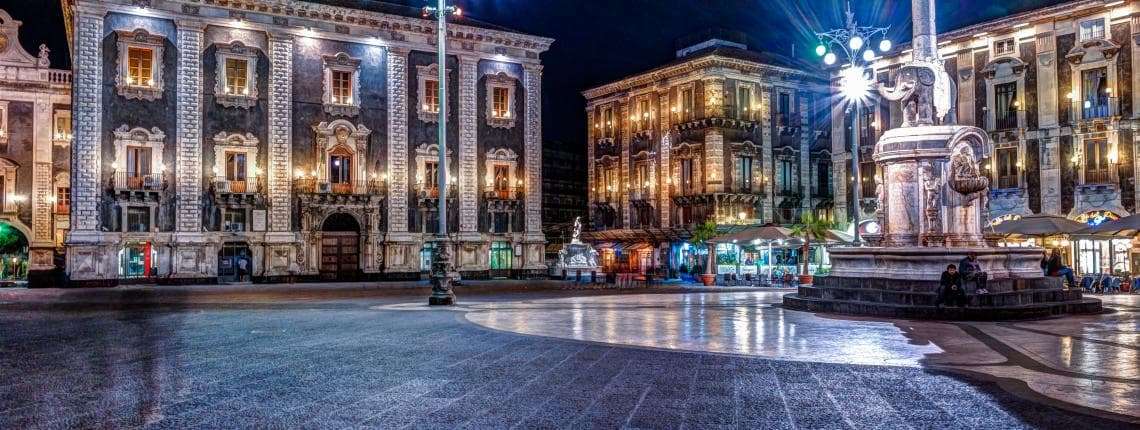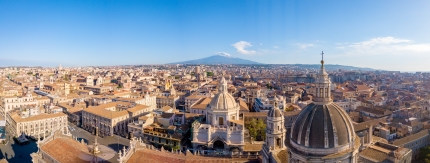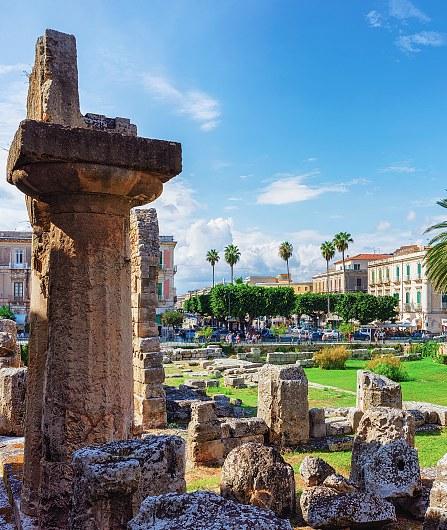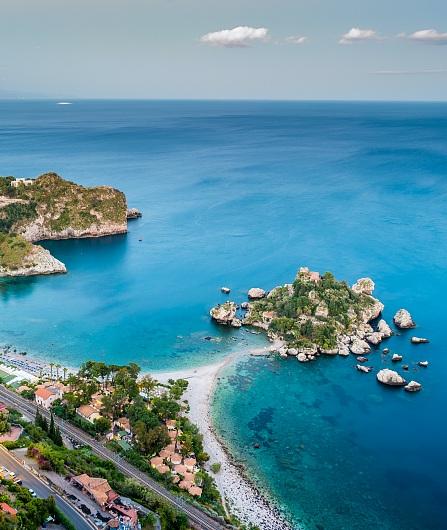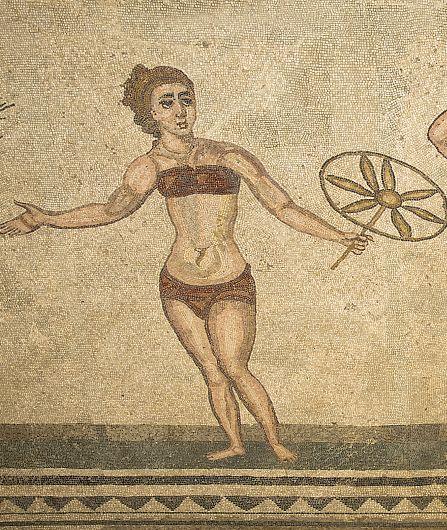The baroque city of Etna
Travel Sicily through history and see authentic and unusual places. Discover the historic center of Catania, the Baroque city, on foot.
With our tour guide, a visit to Aci Castello and its Norman castle in lava stone is also planned.
Without forgetting a walk in Acitrezza, to see the volcanic rocks of the Cyclops (birthplace of Etna) and the giant Polyphemus.
- Catania in Roman times: the Roman theater, the Odeon, the Roman amphitheater and the thermal baths.
- Catania in the Middle Ages: the Bonaiuto Chapel, the Cathedral of Sant'Agata, the Church of Sant'Agata al Carcere, the Ursino Castle.
- Catania in the Renaissance: the Benedictine monastery, the walls of Charles V, the fountain of the "seven channels".
- Baroque Catania: after the eruption of 1669 and the earthquakes of 1693, Catania was almost completely rebuilt in Baroque style.
What to do in Catania
This experience is offered in a private formula: you will benefit from the support of our tour guide, exclusively for you. The private itinerary includes a visit to Catania, Aci Castello and Acitrezza.
Catania is a splendid baroque city
Catania is located on a vast citrus plain on the Ionian Sea, at the foot of Mount Etna. Already a Calcidesi colony in 729 BC, Catania was dominated by various tyrants and peoples, with a period of great splendor that lasted until the imperial and Byzantine domination. A terrible eruption of Etna in 1669 seriously damaged the city, and the disastrous earthquake of 1693 accelerated its progressive decline. The current urban layout dates back to the reconstruction of the city of Catania in the 18th century. Catania can boast magnificent and interesting ruins, one of which is the Greco-Roman theater in via Teatro Greco, with a capacity of 7000 seats: only a part is visible, the rest has been incorporated by the surrounding buildings. Excavations have brought to light some parts of the stage, the large auditorium and the orchestra pit. On the side of the monumental building there is an Odeon, a small theater used for choirs, with a capacity of 1300 people. The portico and the architectural features make it an unusual archaeological testimony. In Piazza Stesicoro we can see the large amphitheater dating back to the 2nd century AD: it is one of the largest Roman remains still existing, with a capacity of 15,000 people, partly hidden by modern buildings and streets.
What to eat in Catania
Taste the arancini (stuffed rice balls), pizzas, ricotta cannoli, granitas, ice creams and almond pastries. Without forgetting the granita with brioche. You cannot leave Catania without having tasted the granita, a sorbet made with crushed ice. Taste the pasta alla Norma, the Catania specialty, the ingredients: aubergine sauce, tomato and ricotta (it owes its name to Norma, a work by Vincenzo Bellini).
What to see in Catania
Via Etnea (covered with lava pebbles), Via Vittorio Emanuele II, Via Plebiscito and Via Giuseppe Garibaldi. At the beginning of February, come for a tour to see the feast of Sant'Agata, patroness of the city of Catania. To see in Catania the Massimo Vincenzo Bellini theater (famous composer from Catania), Palazzo Biscari, the pescheria (fish market), Piazza Stesicoro. The public gardens of Villa Bellini, the Duomo. Piazza Duomo and the Liotru (the lava stone elephant). Castello Ursino, via Crociferi (with palaces and baroque churches). The Roman Theater and the Massimo Bellini Opera House. Visit the fish market and the market in Piazza Currò, near Piazza del Duomo. In the evening, in the center you will find many places to eat and socialize.
Visit to Aci Castello and Acitrezza
The villages are 30 minutes from Catania, a car journey is necessary. Aci Castello, 9 km from Catania: its territory borders the Cyclops Islands, a protected marine area. Acitrezza is characterized by the rocks of the Cyclops. A visit to the castle of Aci on its basaltic promontory, Acitrezza and its islands of the Cyclops is planned. Aci Castello is a town of about 20,000 inhabitants. This city takes its name from the Norman castle which dominates the coast. Aci Castello is built on a lava rock, of previous geological formation to that of the Etna volcano. The rock is characterized by the presence of lava cushions which testify to marine eruptive activity. History: Aci Castello and the other Aci would be from Xifonia. A mysterious disappeared Greek city, probably today located in the territory of the municipality of Aci Catena. The poets Virgil and Ovid gave birth to the myth of its foundation, taken from the love story between the nymph Galatea and the shepherd Acis, as well as from the cyclops Polyphemus (in turn in love with the beautiful Galatea). In Roman times there was a city called Akis, which participated in the Punic wars. The history of the medieval Jachium, then of Al-Yag and the other villages in the area closely coincides with that of the castle of Aci. Under Spanish rule, conflicts broke out between New Aquilia (Acireale) and the farms of Aci, which determined their administrative autonomy. Environment and territory: Aci Castello is today at the center of a coastal territory that attracts for its extraordinary charm. It is formed by the hamlets of Acitrezza, Capomulini, Cannizzaro and Ficarazzi. Also worth seeing are eighteenth-century works in lava stone, secular trees or votive aedicules, among which those dedicated to Sant'Agata, the Ecce Homo and the Madonna di Valverde stand out. Acitrezza is 11 km from Catania. Its history has been linked for centuries to fishing, still practiced today, according to traditional methods. The site is characterized by rocks also called "rocks of the Cyclops". Picturesque basalt pinnacles, which according to Homeric legend were hurled by the giant Polyphemus towards Ulysses. Close to the coast is the Lachea Island, which currently houses the headquarters of a biology station of the University of Catania. This is the place where the Etna volcano was born. From a naturalistic point of view, the complex of the Faraglioni and the Lachea Island is a magnificent regional nature reserve. It is a geological environment of rare beauty, the result of an ancient submarine eruption (it was the cradle of the Etna volcano about 550,000 years ago). The majestic columnar basalts and the small island complex hold minerals and various plant and animal species. In 1881, in the seaside village of Aci Trezza, the writer Giovanni Verga established the famous novel "I Malavoglia".
Visit Catania, the Baroque city
Catania is Sicily's second largest city, sits at the foot of Mount Etna and offers many glimpses of the active volcano. Catania has a strong personality given its turbulent and painful past, it is an ancient city almost rebuilt following the terrible earthquake of 1693. Catania is a late Baroque city in the Val di Noto (south-eastern Sicily), exceptionally testifying to the exuberant genius of late Baroque art and architecture, the last flowering of Baroque art in Europe at its peak. Catania is on the UNESCO World Heritage List. The ancient historic center of Catania begins from the hill of Montevergine (now Piazza Dante), characterized by "archaeological stratifications" since the Neolithic age. Around the eighth century BC, the legendary Greek acropolis Katane was built on the top of the hill, the center of religious and political life, which straddled the houses and roads of the Roman Catina. Catania is a city of about 500,000 inhabitants, the metropolitan area of Catania is the seventh in Italy for residents. Founded in 729 BC by Calcide, it has a long history characterized by various dominations whose remains enrich the artistic, architectural and cultural heritage. Catania was conquered by the Romans in 263 BC, who left architectural remains from the Augustan era. The Byzantine domination was followed by the Arab one, then the Norman one, which brought many changes and innovations to the city, such as, for example, the construction of the Cathedral in Piazza Duomo and the numerous monasteries. Under the Aragonese dynasty it was the capital of the Kingdom of Sicily and it was in this period that the first university of the island was born. Over the centuries, Catania has been repeatedly hit by volcanic eruptions (the last one in 1669) and earthquakes (the most catastrophic in 1693). From the end of the 17th century, an important phase of reconstruction began according to "modern canons". The damaged buildings were demolished and new ones were built over the layers of rubble, raising the level of the city that has come down to us as we know it today. In 2002 the Baroque of the historic center of Catania was declared a World Heritage Site by UNESCO, together with that of seven cities of the Val di Noto (Caltagirone, Militello in Val di Catania, Modica, Noto, Palazzolo Acreide, Ragusa and Scicli).
Beds in Catania and surroundings:
B&B Acqua dell'Arte, Via Cristoforo Colombo, 46, 95121 Catania. Hotel Biscari, Via Giovanni Anzalone 7, 95131 Catania. B&B Catania Globetrotter, Vicolo della Lanterna, 14, 95121 Catania. B&B Faro, Via S. Michele, 26, 95131 Catania. UNA Hotel Palace, Via Etnea, 218, 95131 Catania. Sheraton, Via Antonello da Messina 45, Aci Castello, 95021 Catania. 4 Spa Resort Hotel, Via Nazionale, 114, 95021 Aci Castello CT. Zash, SP2/I-II 70 Riposto CT Donna Carmela, Contrada Grotte 7 Carruba. Ramo d’Aria, Viale delle Provincie 261 Giarre CT. La Terra dei Sogni Hotel Agriturismo 95013 Fiumefreddo di Sicilia CT. Casa del Marchese B&B. Via Guglielmo Marconi 20 95018 Riposto. Kemmare Spiaggia. Via la Vie Fuille 57 Riposto. Sunshine. 29 Lungomare Edoardo Pantano Riposto. B&B Casabella. Via Circumvallazione 77 Riposto. Acqua E Fuoco Chez Rachel. Via Antonio Gramsci 208 Riposto. Sicilia Etna Mare. Via Antonio Gramsci 106 Riposto. Le Giare B&B Spiaggia. Via Cavour 233 Riposto. Casa del Marchese B&B. Via Guglielmo Marconi 20 Riposto.
Restaurants in Catania:
Me Cumpari Turiddu. Piazza Turi Ferro 36-38 CT. Il Sale Art Café. Via Santa Filomena 10-12 CT. Trattoria Paranza. Via Calì 11 CT. Al Vicolo. Via del Colosseo 5-7 CT.
- Be prepared to walk around 3 hours on foot.
- We can reserve for you: accommodation, trips, transfers and visits.
